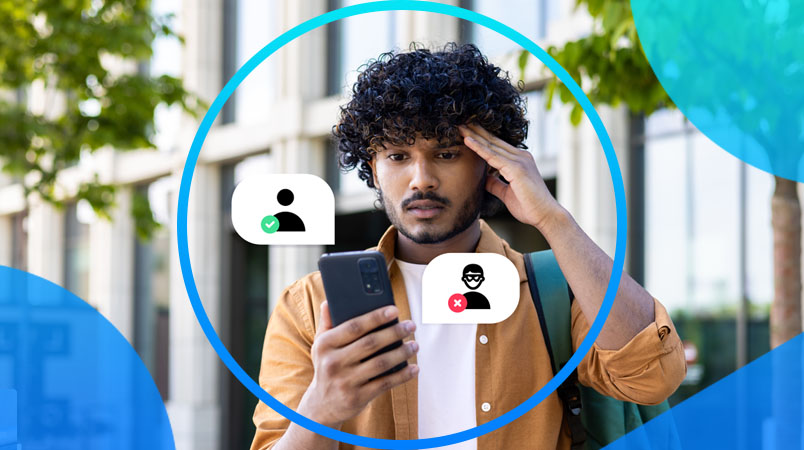Two-Factor Authentication (2FA) vs Multi-Factor Authentication (MFA)
Multi-Factor Authentication (MFA) requires users - your customers or your employees, for example - to identify themselves through multiple means of authentication.
In most situations, users would usually log in via Single-Factor Authentication i.e using a password alone, whereas MFA requires at least a combination of two or more factors of authentication, including:
A password or a PIN.
Verification codes, such as One Time Passwords (OTP).
Physical tokens, such as a USB.
Fingerprints or facial recognition.
Two-Factor Authentication (2FA), the most used form of MFA, demands two distinct identifiers to confirm the user's identity, typically a password along with a One Time Password sent to a user's device, whether via SMS, WhatsApp or even Voice.
This may sound complicated, but using various types of 2FA is quite common in users' daily lives. For example, your customers and employees will be used to entering a password to access social media channels and then receiving a verification code via SMS to complete the login. Or using a fingerprint or facial recognition to log in to an online banking app.
But why use 2FA in business? A key part of any business is protecting users' safety and online accounts and data, especially when using mobile or online channels. Not to mention the many benefits, such as reducing fraud and data theft, increasing customer trust, improving the customer experience and simplifying the login process.
Two-Factor Authentication (2FA) benefits
Before we dive into how can your business ensure employee and customer adoption when it comes to 2FA adoption, let's have a look at the key benefits of 2FA.
1. Enhanced security
2FA provides an additional layer of security. Even if a hacker obtains the password or login credentials of a user, for example, they still won't be able to access sensitive data or information without a second factor of authentication.
2. Reduce the risk of fraud and data breaches
Data breaches have serious consequences for businesses: reputation damage, legal liabilities and even financial losses. As stated above, enhanced security makes it much harder to access the data, not only protecting the individual user but also lowering the risk of a data breach.
3. Ensure compliance
Organisations require specific compliance measures, such as GDPR. The finance and housing industries, for example, demand that businesses follow strict guidelines that protect consumers’ rights and mitigate risk. 2FA can ensure businesses are on the right track and remain compliant.
4. Increase customer trust
Customers like knowing their data is secure and showcasing your commitment to data security will build trust. Even though additional verification steps can seem unnecessary at times, customers trust and appreciate businesses that take precautions to protect them.
5. Simplify the login process
The invention of Single Sign-On (SSO) logins has made 2FA much easier. SSO enables users to log in to multiple applications and websites with one set of credentials, often via One Time Passwords.
6. Reduce operating costs
2FA helps reduce the occurrence of fraud and thus frees up time for the help desk to focus on more complex customer service issues. But that's not all. Compared to other security measures 2FA is relatively low-cost and easy to implement. This makes it a practical and cost-effective option for businesses of all sizes.
Best practices for 2FA
As we've seen 2FA has many benefits and is a strong way to secure and protect data. However, it requires an extra step for users - your employees and customers - which can often make them hesitant to adopt it.
If you want users to adopt new safety measures, you have to ensure they are user-friendly and don't disrupt or negatively impact their current experience—minimise user friction to maximise adoption rates.
Customer 2FA adoption
Let's start with your customers. You want to prevent chasing your customers away with complicated security measures, but you also want to keep them safe in your care. Setting up an account and signing up for your services should have a low threshold, but it can't be too easy because you want to avoid spam and malicious usage. It's a delicate balance between implementing safety measures and retaining ease of use.
So, how do you keep your security measures user-friendly for customers? There's no failsafe answer, but there are some best practices to keep in mind to enhance the customer experience.
How to keep 2FA user-friendly for customers
Educate your customers on the benefits of 2FA. If customers see the value of data protection, they'll become more willing to take that extra (security) step instead of viewing it as an additional, unnecessary task.
Combat username and password fatigue and be careful with your password requirements. According to NordPass, the average internet user has between 70 and 80 passwords. Help your customers by creating an easy-to-remember username for your services, an email address as a username for example.
Give your customers a choice between different authentication options or channels. Customers are more likely to adopt your 2FA strategy when they can use channels they already use and trust.
Allow your customer a suitable amount of time to enter their verification code or One Time Password. The verification process may take a while, depending on connection, channel, and demographics.
Don't expect customers to adopt, purchase or download another app, software, or device just to verify themselves. They may not be willing to do so.
Enable your customers to "remember trusted devices" to minimise the need for log-ins. This is, of course, advised for low-risk cases. When sensitive data is at risk, repeated verification is a necessity.
Employee 2FA adoption
Not only do your customers need some convincing when it comes to adopting security measures, but your employees will also need to be on board. The biggest exasperation for employees is logging into multiple software platforms and devices just to be able to do their job. It's important to find a way to secure and protect your employees and their data without compromising their time and workflow.
How to keep 2FA user-friendly for employees
Be transparent about your security measures. Explain to your employees why the security measures are necessary, how they work and why you chose to implement these specific measurements. Your employees will be more willing to adopt your security strategy when they understand the necessity.
Stronger forms of authentication via third-party authenticator apps on your employees' phones can work as a second layer of security on top of a strong password. An authenticator app can push a prompt to your employees, which they just have to click or tap to accept—no more copying and pasting codes.
Use Single Sign-On (SSO) to make 2FA easier. SSO enables your employees to log in to multiple applications and websites with one set of credentials. This will optimise their time and improve their workflow.
Get started with Two-Factor Authentication (2FA)
Security measures are part of every organisation and therefore should be front of mind. By adhering to the best practices above, you'll be able to both protect your business and customer data, while also providing a seamless and secure experience to both customers and employees.
Are you interested in implementing 2FA into your business? Talk to one of our experts for advice and insights for your specific use case, or read more about our One Time Password (OTP) solution.





